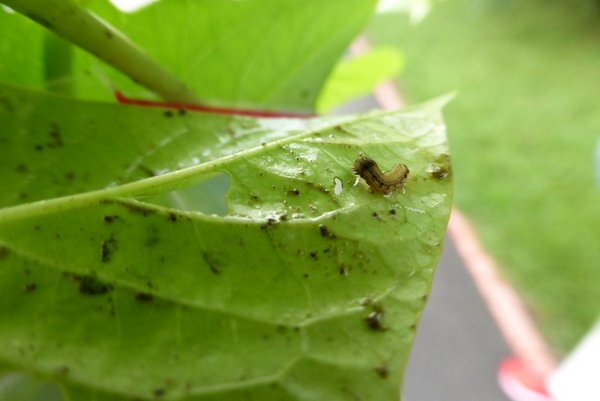- Share this article
- Subscribe to our newsletter
Sweet potato uses a single odour to warn its neighbours of insect attack
Sweet potatoes (Ipomoea batatas) are becoming more and more popular. Although economically still not as important as the potato world-wide, the sweet potato has a higher nutritional value and is richer in vitamins. Particularly in Asia, the crop is an important source of nutrients.
Different cultivars of sweet potatoes are available, all displaying their own characteristics. Even cultivars grown in the field under similar conditions may differ strikingly with respect to insect attack. In previous studies, a cultivar known as Tainong 57 had demonstrably higher resistance to field herbivores in comparison to the cultivar known as Tainong 66.
When attacked, the plants’ leaves emit a distinct odour bouquet. Researchers at the Max Planck Institute for Chemical Ecology in Jena, Germany, and at the National Taiwan University wanted to find out whether the high insect resistance in one cultivar was related to this odour. They especially wanted to find out whether sweet potatoes have mechanisms to activate defence responses via volatile signals, as described in other plant species.
The plant hormone sporamin makes attacking insects lose their appetite
First the scientists examined what happens in a plant after it has been attacked by herbivores. Plants of the resistant cultivar synthesise a plant hormone in the wounded leaves that is important in activating defence mechanisms. These plants also emit a bouquet of odours. As a result, a substance (sporamin) is formed in Tainong 57 leaves that are not directly affected by the attack. Sporamin inhibits digestive enzymes in the attacking insects and causes the herbivores to completely lose their appetite.
At the same time, sporamin is the dominant storage protein in the tuber and the reason why sweet potatoes must be cooked before being consumed. In the odour bouquet, only a single substance, DMNT, is responsible for this defence response. “DMNT is a terpene compound and smells almost a bit like herbal balm,” says Anja Meents, first author of the study and doctoral researcher at the MPI for Chemical Ecology in Jena, describing the scent.
DMNT triggers the formation of the defence protein not only in the affected plant but also in neighbouring plants that have not yet been attacked by herbivores. These plants are able to perceive the smell quickly and efficiently in order to prepare themselves to meet the impending threat.
“To our surprise, just one single volatile is enough to induce a specific defence reaction in a sweet potato plant of the Tainong 57 cultivar. Moreover, the same substance is simultaneously used by the plant for communication with neighbouring plants in order to transmit important information,” points out Axel Mithöfer, head of the Research Group Plant Defense Physiology at MPI.
Interestingly, only plants of the resistant Tainong 57 cultivar released DMNT in high concentrations and were able to perceive the odour. Plants of the Tainong 66 cultivar, in contrast, released significantly less DMNT; even when the level of DMNT was increased, plants of this herbivore-susceptible sweet potato cultivar were unable to improve the effectiveness of their defence response.
“Our results are of great agricultural importance, because the consistent cultivation of resistant cultivars such as Tainong 57 could help to considerably reduce the damage caused by herbivores in a natural way,” Meents explains, indicating the practical potential of the study. The development of cultivars that release higher amounts of DMNT and which can perceive DMNT more efficiently compared to the cultivars in the study could further minimise the use of pesticides.
In future studies, the team of researchers would like to examine more closely how Tainong 57 perceives DMNT and transfers the signal into a defence response.
(idw/wi)
Original Publication:
Meents, A. K., Chen, S.-P., Reichelt, M., Lu, H.-H., Bartram, S., Yeh, K.-W., Mithöfer, A. (2019). Volatile DMNT systemically induces jasmonate-independent direct anti-herbivore defense in leaves of sweet potato (Ipomoea batatas) plants. Scientific Reports, 9, 17431, DOI:10.1038/s41598-019-53946-0





Add a comment
Be the First to Comment